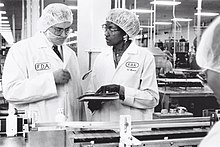Pharmaceutical industry

The pharmaceutical industry produces medicines. Companies discover, develop, produce, and market drugs for use as medications. They aim to cure and prevent diseases, or to control symptoms.[1][2] Some are given to patients by healthcare workers. Some may be managed by patients themselves. Some drugs need a prescription to be bought. Drugs that do not require a prescription are called "over the counter" medications.
Pharmaceutical companies may deal in generic or brand medications and medical devices. They are subject to many laws and regulations that govern the patenting, testing, safety, efficacy using drug testing and marketing of drugs. Across the world treatments worth $1,228.45 billion were produced in 2020. There was a compound annual growth rate of 1.8% in the industry..[3]
Producing medicines starts with making active pharmaceutical ingredients. They are then turned into doses ready for patients. Inactive ingredients such as preservatives are added, usually in a different factory. Then they are sent to distribution centres. Most of the manufacturing is done in Indian and Chinese factories. Factories may be inspected by the FDA, or similar organisations to check for quality.
In the 2020s there were repeated shortages of many generic medicines . These are off-patent. They are much cheaper than the new medicines which are covered by a patent, which lasts for up to 20 years. 91% of drugs prescribed in the US and 70% in Europe in 2023 were generics. Profit on these drugs is very low. There are not many different suppliers for many drugs. The supply chains are not very strong. When there are shortages less developed countries may get none. There are sometimes other medicines which can be substituted if there are supply problems. It may take a long time for a new supplier to start up. Sometimes patients come to harm because the medicine they need is not available. [4]
References[change | change source]
- ↑ McGuire, John L.; Hasskarl, Horst; Bode, Gerd; Klingmann, Ingrid; Zahn, Manuel (2007). "Pharmaceuticals, General Survey". Ullmann's Encyclopedia of Industrial Chemistry. Wiley. doi:10.1002/14356007.a19_273.pub2. ISBN 978-3527306732.
- ↑ Bozenhardt, Erich H.; Bozenhardt, Herman F. (18 October 2018). "Are You Asking Too Much From Your Filler?". Pharmaceutical Online (Guest column). VertMarkets. Archived from the original on 17 November 2020. Retrieved 30 October 2018.
The core mission of the pharmaceutical industry is to manufacture products for patients to cure them, vaccinate them, or alleviate a symptom, often by manufacturing a liquid injectable or an oral solid, among other therapies.
- ↑ Markets, Research and (2021-03-31). "Global Pharmaceuticals Market Report 2021: Market is Expected to Grow from $1228.45 Billion in 2020 to $1250.24 Billion in 2021 - Long-term Forecast to 2025 & 2030". GlobeNewswire News Room (Press release). Archived from the original on 29 November 2021. Retrieved 2021-11-29.
- ↑ "The world's broken market for medicines". www.ft.com. Retrieved 2024-03-28.
